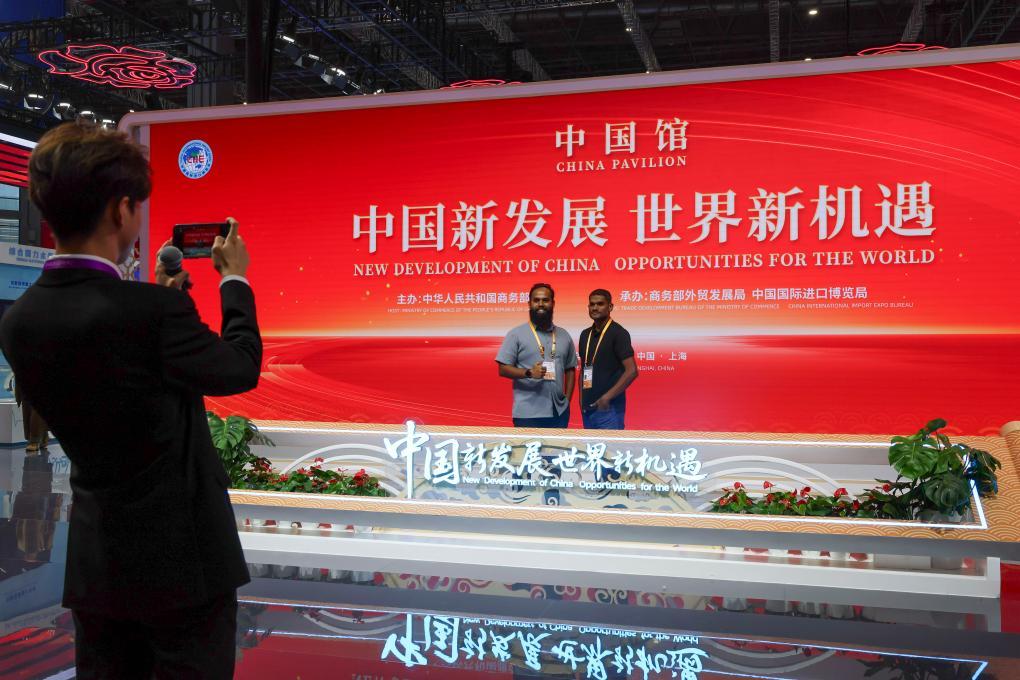




Foreign exhibitors pose for photos at the China Pavilion during the eighth China International Import Expo (CIIE) in east China's Shanghai, Nov. 10, 2025. [Photo/Xinhua]
From Nov. 5-10, Shanghai welcomed the eighth edition of the China International Import Expo (CIIE). For those following global trade, the event seems to reinforce a simple yet powerful point: Openness is not an abstract concept – it can be a practical tool for generating real opportunities. It offers a clear illustration of how policy, market access and innovation can intersect to create tangible outcomes.
The CIIE is far more than a conventional trade fair. It brings together international companies, governments and research institutions in a highly interactive environment where partnerships can be explored and innovation showcased. The 2025 expo appears to have underscored that China's market is not only immense but also concrete and actionable, presenting substantial potential for those willing to engage strategically.
The scale of participation was particularly striking. Over 4,100 exhibitors from more than 150 countries and regions attended, including nearly 300 Fortune Global 500 companies. The exhibition spanned more than 430,000 square meters – the largest in the expo's history – and covered a wide range of sectors, from intelligent manufacturing and consumer goods to health care and medical equipment, food and agricultural products, and services trade. These numbers are impressive on paper, but the scale seems to reflect something more: a strong international confidence in China as a partner and market.
Developing economies were a notable feature this year. More than 160 companies from 37 least-developed countries participated, with representation by African enterprises rising by 80% compared to 2024. Exhibitors presented a diverse mix of goods, including coffee, cocoa, tropical fruits, tea, spices, textiles and handicrafts, while connecting directly with China's retail, wholesale and e-commerce channels. This aspect highlights a practical dimension of the CIIE: It is not merely a display platform, but a real opportunity for smaller economies to reach one of the world's largest and most sophisticated consumer markets.
Innovation remained at the heart of the expo. In total, 461 new products and services were introduced, covering areas such as artificial intelligence, humanoid robotics and green technologies. Of particular note was that companies were not simply showcasing products; they were preparing for long-term engagement. Take Medtronic, for example. The medical device company unveiled over 500 products, including 70 debuting in China, spanning diagnostic imaging, minimally invasive surgery and patient management solutions. Consumer goods firms also demonstrated attention to local needs, introducing eco-friendly packaging, digitally integrated designs and service-oriented products. With a market of over 800 million middle-income consumers, it appears that success in China often requires adaptation rather than a one-size-fits-all approach.
Sustainability and technological advancement were prominent all throughout the expo. Exhibitors highlighted energy-efficient machinery, recyclable materials and resource-optimizing solutions. Manufacturing halls featured automated production lines, real-time monitoring systems and energy-saving equipment, while health care booths presented advanced diagnostic tools and patient management platforms.
These examples suggest that China's openness is practical: International firms can align with policy priorities while delivering measurable, market-ready outcomes. The emphasis on innovation and sustainability seems less like a trend and more like a clear signal of where long-term collaboration can produce concrete benefits.
The policy environment further reinforces these opportunities. With an overall tariff level of 7.3% and China maintaining its position as the world's second-largest import market for 16 consecutive years, the conditions for multinational firms appear stable and predictable. Policies promoting fair competition, transparency and support for both domestic and foreign enterprises also help boost confidence. Beyond product exhibitions, the CIIE provides forums on customs procedures, standards and investment guidance. These structured settings transform the abstract concept of openness into an actionable framework for companies seeking to enter or expand in China.
Long-term partnerships are another important dimension of the expo. Beside immediate transactions, the CIIE facilitates engagement among financial institutions, trade agencies, industry associations and business representatives. Historically, more than 1,100 foreign-funded enterprises have participated in targeted matchmaking events, generating intended transactions exceeding $500 billion. This track record seems to reinforce the point that the CIIE is not merely symbolic. It produces measurable, high-impact outcomes that justify the effort, time and investment companies dedicate to participation.
This combination of scale, innovation and structured opportunity is what makes the CIIE a model for meaningful openness.
Additionally, the expo highlights the increasing role of China as a springboard for global trade. Developing economies are leveraging access to Chinese channels not only to reach local consumers but to build connections that extend internationally. This underscores a practical point: Structured openness can generate measurable benefits not just for large multinational firms, but also for smaller players seeking global exposure.
With the expo having now concluded, a clear takeaway has emerged: Deliberate engagement, transparent policies and structured access produce results. International firms can use the CIIE to launch products, test localization strategies, explore technological innovations and forge sustainable partnerships. Smaller economies gain entry to global markets, while multinational companies see the advantages of long-term collaboration. The event demonstrates that openness is most effective when it is concrete, measurable and mutually beneficial.
Ultimately, the eighth CIIE shows that linking innovation, trade and policy within a single platform can produce tangible results. Products launched, partnerships formed, markets entered – these are measurable outcomes that go beyond abstract promises. For anyone assessing China's economic landscape, the expo seems to confirm a simple, powerful point: The Chinese market is not only accessible; it is also practical, actionable and offers significant opportunities.
Dr. Shamuratov Shovkat is a researcher in international trade and economics at Jiangxi Fenglin College of Foreign Economy and Trade in Jiujiang, China.
Copyright ? 2001-2025 湖北荊楚網絡科技股份有限公司 All Rights Reserved
互聯網新聞信息許可證 4212025003 -
增值電信業務經營許可證 鄂B2-20231273 -
廣播電視節目制作經營許可證(鄂)字第00011號
信息網絡傳播視聽節目許可證 1706144 -
互聯網出版許可證 (鄂)字3號 -
營業執照
鄂ICP備 13000573號-1  鄂公網安備 42010602000206號
鄂公網安備 42010602000206號
版權為 荊楚網 www.cnhubei.com 所有 未經同意不得復制或鏡像